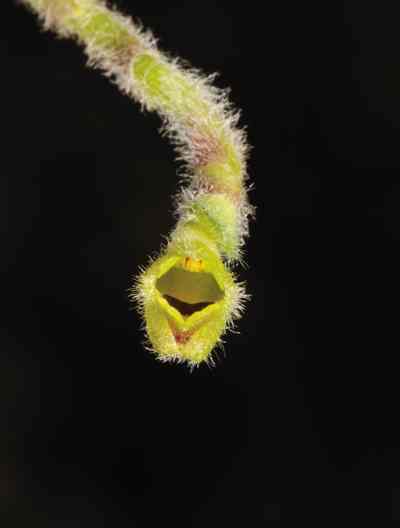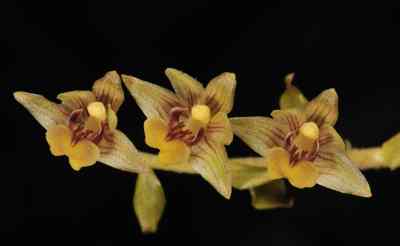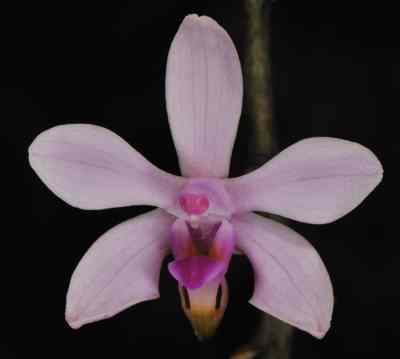Epiphyte, but seen as lithophyte also in many habitats. A spreading plant with very narrow and hairy creeping stems. Leaves small, obovate, sessile, fleshy with hairy surfaces. Flowers small, less than 1 cm across, solitary, on pubescent peduncles. Sepals and petals are of a pale green colour flushed with yellow. Lip is of the same shade but with a large dark purple blotch on its disc and a few pale brown spots at its base. The anther cap got two bright red markings. Sepals unequal, dorsal small, elliptic; the lateral pair large, triangular; both externally pubescent. Petals smaller than the sepals, oblong. Lip large, oblong, with narrowed base, side lobes very shallow, the terminal slightly deflexed.

The Pursuit
A very rare plant in its natural habitats. To my surprise I found this species on a roadside tree during one of my routine surveys. It was a tall single trunk tree to the right side of the road on the valley. Every time I pass through that location I make a short break there to see the tree and this species. I was aware of its blooming season from my referral book. The flowers are so small and not much documentary evidences about its flowers were available. Moreover, I am fond of documenting small flowers, where I can use my skills very well. By the first monsoon showers itself, I noticed buds developing on those small stems. The plants were high as 24 ft, quite a terrifying height when the tree is single trunk and in a valley. To avoid risky climbing on that tall tree everyday, I had erected a flat top ladder and was observing the plants and its flowers from very close quarters. Within ten days, most of the buds were in bloom. Then only I observed that the flowers are less than a cm across and got a lot of colour variations externally and also few markings and spots inside its small lip. On the base of the lip, the colour variation was more interesting. It was like gradually changing from pale to dark shade. I wanted those colourations to be recorded without any manipulations and tried hard with the micro flashes. Even the use of micro flashes were not of any help. The opening of the lip was just 8 mm only and the flash lights were not able to lit inside the lip. As there were a lot of buds and flowers I was having some time to rethink and plan my strategies. For the next few days, emails flew across continents and hours of phone calls to many people ended up with a new idea of using an optical fibre cable to light up the inside of the lip. Two optical fibre cables were brought all the way from the Land of Rising Sun in a chartered supersonic jet. The same was brought to the hills in a helicopter. Due to the combined ideas and efforts of several people things were made easy for me. Rest was something great, the use of a new technology till now unknown to the world. The images I produced with that new technology was amazing. It brought out till unknown details of a small flower. Also it had opened the flood gates for future flower photography too. I owe a lot to many people around the globe for this wonderful idea and this beautiful photograph.





